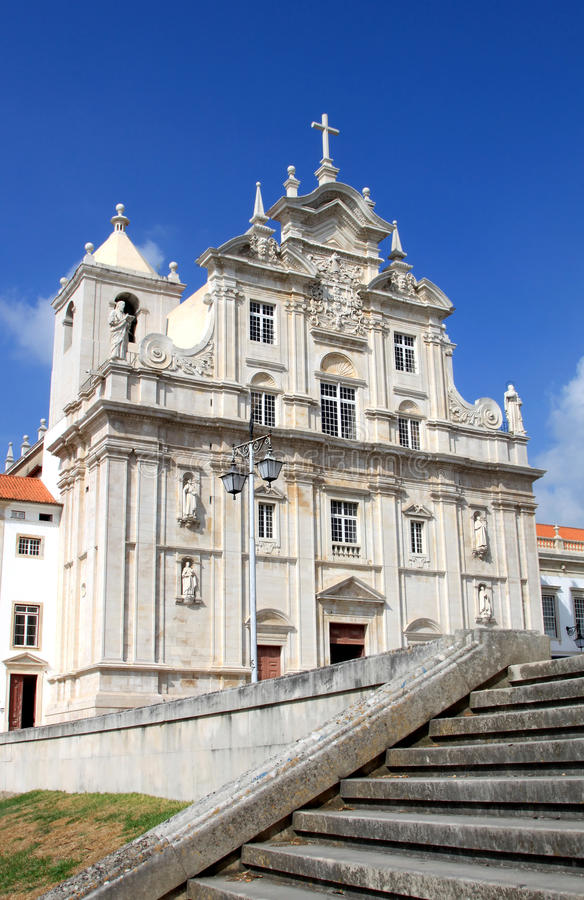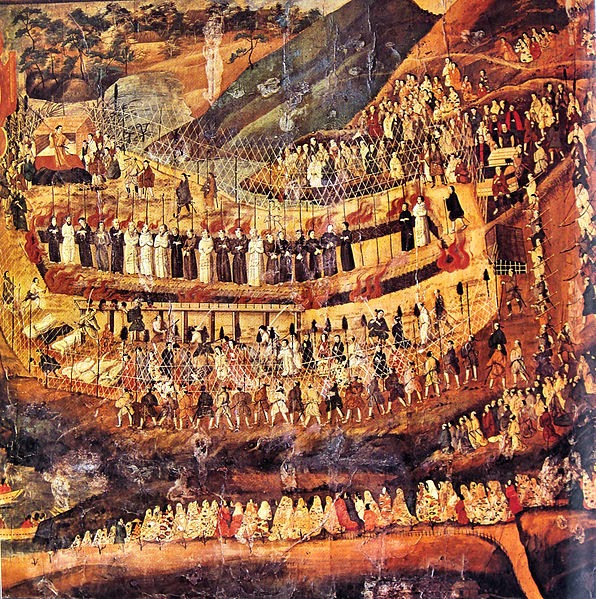Blessed James Carvalho, SJ
Born: Circa 1578
Died: February 22, 1624
Beatified: May 7, 1867
 Fr Carvalho was born in Coimbra, Portugal. He entered the Coimbra Jesuit Novitiate in 1594. In 1600, he left Lisbon for Goa for his philosophy studies. A year later, he went to Macau to complete his philosophy and theology studies and was ordained a priest in 1608. In 1609, he sailed to Japan and arrived there the following year where he found the Christian communities thriving and enjoying great peace. He spent his first year in Japan studying the language and after doing missionary work in Amakusa for 2 years, he was transferred to Miyako (today’s Kyoto) where he evangelized without interference or fear. The peace was brutally shattered in 1614 after 16 years when Shogun Iyeyasu issued a decree banishing all foreign missionaries and ordered the closing or destruction of all Christian churches. Fr Carvalho, together with about 100 other Jesuits, were deported and taken to Macau. During this period of enforced exile, he was the co-founder of the Japanese mission in Cochin China. His dream was to return to his mission in Japan, which he secretly did in 1616. Later he joined Fr Jerome De Angelis in Northern Japan, where they cared for the refugees who escaped from the south. Fr Carvalho worked among the miners in Oshu and Dewa and converted many of the miners. He suffered from the harsh climate, having to live in caves, barns and huts. Despite the harsh weather, he succeeded in visiting all the Christians in all the districts and also in increasing their numbers. He celebrated the first Mass at Matsumae on August 5, 1620.
Fr Carvalho was born in Coimbra, Portugal. He entered the Coimbra Jesuit Novitiate in 1594. In 1600, he left Lisbon for Goa for his philosophy studies. A year later, he went to Macau to complete his philosophy and theology studies and was ordained a priest in 1608. In 1609, he sailed to Japan and arrived there the following year where he found the Christian communities thriving and enjoying great peace. He spent his first year in Japan studying the language and after doing missionary work in Amakusa for 2 years, he was transferred to Miyako (today’s Kyoto) where he evangelized without interference or fear. The peace was brutally shattered in 1614 after 16 years when Shogun Iyeyasu issued a decree banishing all foreign missionaries and ordered the closing or destruction of all Christian churches. Fr Carvalho, together with about 100 other Jesuits, were deported and taken to Macau. During this period of enforced exile, he was the co-founder of the Japanese mission in Cochin China. His dream was to return to his mission in Japan, which he secretly did in 1616. Later he joined Fr Jerome De Angelis in Northern Japan, where they cared for the refugees who escaped from the south. Fr Carvalho worked among the miners in Oshu and Dewa and converted many of the miners. He suffered from the harsh climate, having to live in caves, barns and huts. Despite the harsh weather, he succeeded in visiting all the Christians in all the districts and also in increasing their numbers. He celebrated the first Mass at Matsumae on August 5, 1620.
The prince of Oshu, Masamune who had been favourably disposed towards Christians, became their executioner in 1623. He ordered the governor of Sendai to seek out all Christians and to put to death anyone who refused to apostatize. Fr Carvalho was then staying in Miwake with John de Goto, a fervent Catholic. When Fr Carvalho heard of Masamune’s order, he left the Goto residence so as not to compromise his host. But 2 apostate Christians informed the governor of Fr Carvalho’s whereabouts. Fr Carvalho with 60 Christians, had gone into a deep valley to seek safety but unfortunately, their tracks in the snow had shown exactly where they had gone and the soldiers soon tracked them down. Before the soldiers had a chance to ask for the priest, Fr Carvalho encouraged the other Christians to flee. He then walked up to his captors and identified who he was. All but a dozen of his companions took the opportunity to leave.
 Fr Carvalho and his companions were led by the soldiers on a 7 day march to Sendai. When 2 Christians were unable to keep up with the group, they were beheaded and their bodies hacked to pieces. Upon arrival in Sendai, the prisoners were made to march through the street. They were then taken to prison where they remained for 4 weeks and were fed a handful of boiled rice, just enough to keep them alive. On February 18, the prisoners were taken to the river bank, where they were stripped naked and forced to submerge into a hole measuring several square feet filled with the river’s icy water. The freezing waters came up to their knees and they were made to kneel in Japanese fashion sitting on their heels. From this position, they were told to rise and stand exposed to the cold wind. They were made to do this exercise for 3 hours and when their bodies were numb, they were taken from the pit and offered freedom if they denied their religion. 4 days later, the torture was repeated. Fr Carvalho was in the pit with 7 others and as the day wore on, one by one the companions died but Fr Carvalho, the last of his group, endured well into the night. His voice raised in prayer grew weaker until he was only able to whisper the names of Jesus and Mary. He died in the icy water and the soldiers left his body in the pit until it was claimed by a Christian 2 days later.
Fr Carvalho and his companions were led by the soldiers on a 7 day march to Sendai. When 2 Christians were unable to keep up with the group, they were beheaded and their bodies hacked to pieces. Upon arrival in Sendai, the prisoners were made to march through the street. They were then taken to prison where they remained for 4 weeks and were fed a handful of boiled rice, just enough to keep them alive. On February 18, the prisoners were taken to the river bank, where they were stripped naked and forced to submerge into a hole measuring several square feet filled with the river’s icy water. The freezing waters came up to their knees and they were made to kneel in Japanese fashion sitting on their heels. From this position, they were told to rise and stand exposed to the cold wind. They were made to do this exercise for 3 hours and when their bodies were numb, they were taken from the pit and offered freedom if they denied their religion. 4 days later, the torture was repeated. Fr Carvalho was in the pit with 7 others and as the day wore on, one by one the companions died but Fr Carvalho, the last of his group, endured well into the night. His voice raised in prayer grew weaker until he was only able to whisper the names of Jesus and Mary. He died in the icy water and the soldiers left his body in the pit until it was claimed by a Christian 2 days later.
Because of insufficient information about Fr Carvalho’s companions in martyrdom, they were not included in the decree of his beatification issued by Pope Pius IX in May 7, 1867 .
